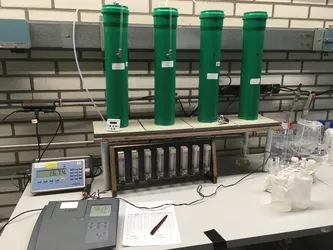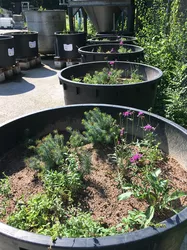SP10: Urban Drainage Systems


Head: Prof. Dr. Brigitte Helmreich
Background
SUDS are typically decentralized stormwater drainage systems with a focus on dewatering. In addition to the retention of pollutants, the improvement of water storage is of great interest to buffer flooding events and provide a cooling effect. It is also important, however, that SUDS do not cause health problems such as allergies due to accumulation of harmful substances. We hypothesize that multifunctional SUDS can be optimized for dewatering and absorbing pollutants from building facades, roofs and traffic areas (heavy metals, biocides, pesticides), while simultaneously benefitting urban biodiversity and climate. To do this, the soil composition and the thickness of the topsoil layer must be adapted. Soils rich in nutrients and the addition of sorption materials are supposed to help increase pollutant removal, while not compromising the main function of safe drainage and allowing for rich biodiversity. Investigations will be done at vegetated infiltration swales as examples of SUDS by examining various soil compositions enriched with carbon-rich and adsorptive substrates and the plant systems suggested by the subproject on soil functionality (SP11). The benefits for human health will be clarified in cooperation with the research on pollen and fungal spores (SP9). An extension of the SUDS enables to cover multiple other functions, e.g., for walking and cycling networks (SP2) and provides therefore a link to Cluster 1.
Objectives
In this project, we will conduct experiments especially with high-carbon organic soil amendments (HCAs) in combination with nutrients aimed to improve urban soil structure and functionality (SP11), as well as sorption material enrichment for contaminant remediation.
We will study the uptake and degradation of pollutants from stormwater runoff at different weather conditions, and analyze the mobility of already retained pollutants using sequential extraction protocols.
The specific objectives are to:
(O1) Investigate the role of different soil amendment combinations to improve the removal of heavy metals and biocides;
(O2) Analyze the physico-chemical mechanisms responsible for the removal of pollutants;
(O3) Investigate the remobilization potential of pollutants in soil remediation strategies.
We predict that:
(H1) HAC additions with and without the addition of sorption materials will increase the removal rates for run-off pollutants;
(H2) An increase in the nutrient content in soil for plant growth, e.g., by the application of composts, will not affect the removal capacity for pollutants;
(H3) Trace organic chemicals are metabolized in the soil but can also be adsorbed, hence removal rate increases with soil amendment;
(H4) With soil amendment, heavy metals can be bound persistently as non-acid-extractable species;
(H5) Despite the enrichment of the soil with carbon-rich material and nutrients, the infiltration rate can be maintained through the additional sorption materials, i.e., the drainage security.
Execution: Natalie Páez-Curtidor
Dissertation: Improvement of soil composition of SUDS for pollutant removal from stormwater run-off while maintaining the drainage function and enabling the implementation of plant biodiversity.
Methods:
Experiments with different organic amendments in consultation with SP11 and different sorption material additions will be conducted to improve the removal capacity for pollutants in SUDS. In stage 1, we will use column tests to investigate the potential of soil mixtures and different abundant and cheap amendments (HCAs, iron oxide, lignite, ion exchanger biochar, etc.) for pollutants removal, i.e., heavy metals (Zn, Cu, Ni, Cd) and three biocides (diuron, mecoprop, terbutryn, and their metabolites). In stage 2, we will use vegetated infiltration swales implemented in outdoor plots at TUM Garching with the best soil mixes from stage 1 and plants from SP12 and SP13. The focus is the removal of pollutants and their remobilization under real conditions like heavy rain events and long dry weather periods. The influent for stage 2 experiments is biocide containing facade runoff as well as heavy metal runoff. We will determine soil organic carbon, water holding capacity, heavy metal and biocide contents as well as the degradation products of biocides in the soil matrix. In the third year, we will analyze the remobilization potential and the bioavailability of pollutants in the pre-stressed soils using sequential extraction protocols. In stage 3, we will analyze existing SUDS in Munich to test their contaminant content to thereby reduce contaminant risks associated with urban food gardening. We will also compare remobilization potential and bio-availability of pollutants already bound in SUDS and evaluate whether our improved soil composition could lead to an improvement. The project is intimately linked to appropriate plant systems (SP13), soil functionality (SP11) and soil micro-biomes (SP12).
Outlook:
Large scale implementation of SUDS in the City of Munich will be studied in the Period II of the RTG.
Execution: Dominik Meier
A current research challenge is to improve urban soil structure and functionality in sustainable urban drainage systems (SUDS). In the first series of experiments, the adsorption of stormwater pollutants from building runoff (biocides and heavy metals) was investigated in the laboratory with two soil types: high-carbon organic soil (HCA) amendments and nutrients from compost. Based on these experiments, the PhD student should transfer the results into a semi-technical scale with real and synthetic stormwater runoff from buildings. We will use vegetated infiltration swales implemented in outdoor plots at TUM Garching with the soil mixes and plant communities investigated by the first PhD cohort. The focus is now on the removal of pollutants and their immobilization under real conditions like heavy rain events alternating with long droughts. The influent for the experiments will be polluted runoff from biocide-treated facades and metal roofs. We will determine soil organic carbon, water holding capacity, heavy metal and biocide contents, and the degradation products of biocides in the soil matrix. Additionally, to the semi-technical scale experiments, we will analyze existing SUDS in Munich to test their contaminant content to thereby reduce contaminant risks associated with urban agriculture. We will also compare the remobilization potential and bio-availability of pollutants already bound in SUDS and evaluate whether the improved soil composition could lead to an improvement.